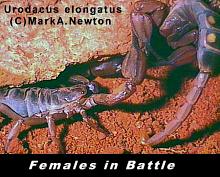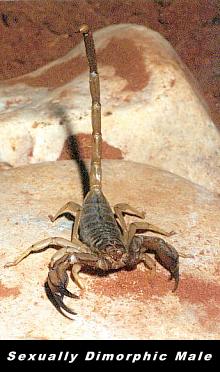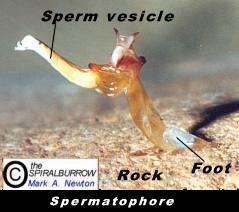Scorpions have a most unusual method for the transfer of genetic material between the sexes. As is the case with spiders and frogs, scorpions transfer the sperm externally and do not actually mate as such. The scorpion mating ritual is known as the promenade a deaux, and I will describe the sequence of events as I have witnessed them of Urodacus elongatus, a large species of Australian scorpion from the Flinders Ranges of South Australia.
The male scorpion is usually the sex to actively seek out the other for the mating ritual. Using airborne pheromones the male picks up the scent and heads off in search of a mate. When encountering the female the male starts a behaviour we call juddering. The juddering must somehow signal to the female that the male is advancing for reasons of a sexual nature. The juddering is a behaviour in which the scorpion jerks it's whole body back and forth quite rapidly. During this time the pedipalps are extended in front with the body held well off the ground. The female will respond with a similar juddering, approaching the male and attacking quite aggressively in this species.
I have witnessed females at the end of mating season who haven't encountered a male look desperately for a mate. Female elongatus seem unable to determine the sex of a potential partner seeking out every scorpion they find in attempt to mate. In the photo at left we have two female scorpions fighting, the one on the right is actively seeking a mate, but the one under the rock has already mated and is fighting off the keen female.
Female elongatus seem unable to determine the sex of a potential partner seeking out every scorpion they find in attempt to mate. In the photo at left we have two female scorpions fighting, the one on the right is actively seeking a mate, but the one under the rock has already mated and is fighting off the keen female.
The male of this species has a very long tail compared with the female and for a very good reason. The female is quite aggressive and will not hesitate to kill the male. The scorpions fight with each other, locking pedipalps. The female tries hard to inflict a fatal body sting to the male. The male holds the female at arms length and brings over his very long tail. She cannot reach the male with her shorter tail and is stung in the hand or arm by the male's aculeus. Once being stung and receiving venom the female becomes drugged and no longer wishes to kill her mate. This behaviour is know as the sexual sting and brings about the sexual dimorphism of the males extremely long tail. She then becomes easy for the male to control, and control is exactly what is needed for a successful sperm transfer.
The female is quite aggressive and will not hesitate to kill the male. The scorpions fight with each other, locking pedipalps. The female tries hard to inflict a fatal body sting to the male. The male holds the female at arms length and brings over his very long tail. She cannot reach the male with her shorter tail and is stung in the hand or arm by the male's aculeus. Once being stung and receiving venom the female becomes drugged and no longer wishes to kill her mate. This behaviour is know as the sexual sting and brings about the sexual dimorphism of the males extremely long tail. She then becomes easy for the male to control, and control is exactly what is needed for a successful sperm transfer.
The male grips the female's pedipalps with his and starts to drag her about the place with the female offering resistance to his movement. The resistance is not unlike that of a tug of war. The female simply doesn't like to move very much, similar to moving a stubborn mule. The male gives the female the cheliceral kiss where he locks his mouthparts onto hers. This behaviour keeps the male's body in perfect alignment with the female's which as we shall see is of utmost importance.
 The male continues to drag the female around until he locates a suitable surface on which he can deposit his spermatophore. The spermatophore is the container that houses the sperm and is placed onto a rock from the male's genital opening.
The male continues to drag the female around until he locates a suitable surface on which he can deposit his spermatophore. The spermatophore is the container that houses the sperm and is placed onto a rock from the male's genital opening. The male uses special sense organs located under his body called pectines to locate the correct surface. The correct surface is vital, if the male chooses a surface too rough the spermatophore's foot may not be able to stick well enough for transfer to the female, losing the all important genes needed to produce the next generation. The male's pectines sweep across the substrate in a brush like manner detecting the regularity of the surface and surface texture. Not only must the surface be correct, but the male must be able to keep the female in perfect alignment with his own body.
The male uses special sense organs located under his body called pectines to locate the correct surface. The correct surface is vital, if the male chooses a surface too rough the spermatophore's foot may not be able to stick well enough for transfer to the female, losing the all important genes needed to produce the next generation. The male's pectines sweep across the substrate in a brush like manner detecting the regularity of the surface and surface texture. Not only must the surface be correct, but the male must be able to keep the female in perfect alignment with his own body.
 When the male is happy with the surface conditions the spermatophore is released from his genital opening and carefully placed onto the substrate below. The very sticky foot of the spermatophore adheres to the rock and remains upright. The male with his body now strongly arched must very precisely pull the female in a direct straight line so her body and genital opening are directly over the spermatophore. The female's genital operculum or plate is at 90 degrees to her body allowing the genital opening to be exposed at a maximum. With the spermatophore at the correct position the female lowers her body allowing the portion of the spermatophore containing sperm to enter her body. The sperm are released, the female raises her body from the spermatophore and without hesitation the pair quickly break apart, the transfer of the all-important genetic information completed.
When the male is happy with the surface conditions the spermatophore is released from his genital opening and carefully placed onto the substrate below. The very sticky foot of the spermatophore adheres to the rock and remains upright. The male with his body now strongly arched must very precisely pull the female in a direct straight line so her body and genital opening are directly over the spermatophore. The female's genital operculum or plate is at 90 degrees to her body allowing the genital opening to be exposed at a maximum. With the spermatophore at the correct position the female lowers her body allowing the portion of the spermatophore containing sperm to enter her body. The sperm are released, the female raises her body from the spermatophore and without hesitation the pair quickly break apart, the transfer of the all-important genetic information completed.
After the event the pair usually rapidly part company, although it is my understanding that as with spiders the female may choose to make a meal of the male if possible. In some species either sex may also choose to consume the spent spermatophore although I have not witnessed this with Urodacus elongatus.
HOME


 Female elongatus seem unable to determine the sex of a potential partner seeking out every scorpion they find in attempt to mate. In the photo at left we have two female scorpions fighting, the one on the right is actively seeking a mate, but the one under the rock has already mated and is fighting off the keen female.
Female elongatus seem unable to determine the sex of a potential partner seeking out every scorpion they find in attempt to mate. In the photo at left we have two female scorpions fighting, the one on the right is actively seeking a mate, but the one under the rock has already mated and is fighting off the keen female. The female is quite aggressive and will not hesitate to kill the male. The scorpions fight with each other, locking pedipalps. The female tries hard to inflict a fatal body sting to the male. The male holds the female at arms length and brings over his very long tail. She cannot reach the male with her shorter tail and is stung in the hand or arm by the male's aculeus. Once being stung and receiving venom the female becomes drugged and no longer wishes to kill her mate. This behaviour is know as the sexual sting and brings about the sexual dimorphism of the males extremely long tail. She then becomes easy for the male to control, and control is exactly what is needed for a successful sperm transfer.
The female is quite aggressive and will not hesitate to kill the male. The scorpions fight with each other, locking pedipalps. The female tries hard to inflict a fatal body sting to the male. The male holds the female at arms length and brings over his very long tail. She cannot reach the male with her shorter tail and is stung in the hand or arm by the male's aculeus. Once being stung and receiving venom the female becomes drugged and no longer wishes to kill her mate. This behaviour is know as the sexual sting and brings about the sexual dimorphism of the males extremely long tail. She then becomes easy for the male to control, and control is exactly what is needed for a successful sperm transfer. The male continues to drag the female around until he locates a suitable surface on which he can deposit his spermatophore. The spermatophore is the container that houses the sperm and is placed onto a rock from the male's genital opening.
The male continues to drag the female around until he locates a suitable surface on which he can deposit his spermatophore. The spermatophore is the container that houses the sperm and is placed onto a rock from the male's genital opening. The male uses special sense organs located under his body called pectines to locate the correct surface. The correct surface is vital, if the male chooses a surface too rough the spermatophore's foot may not be able to stick well enough for transfer to the female, losing the all important genes needed to produce the next generation. The male's pectines sweep across the substrate in a brush like manner detecting the regularity of the surface and surface texture. Not only must the surface be correct, but the male must be able to keep the female in perfect alignment with his own body.
The male uses special sense organs located under his body called pectines to locate the correct surface. The correct surface is vital, if the male chooses a surface too rough the spermatophore's foot may not be able to stick well enough for transfer to the female, losing the all important genes needed to produce the next generation. The male's pectines sweep across the substrate in a brush like manner detecting the regularity of the surface and surface texture. Not only must the surface be correct, but the male must be able to keep the female in perfect alignment with his own body. When the male is happy with the surface conditions the spermatophore is released from his genital opening and carefully placed onto the substrate below. The very sticky foot of the spermatophore adheres to the rock and remains upright. The male with his body now strongly arched must very precisely pull the female in a direct straight line so her body and genital opening are directly over the spermatophore. The female's genital operculum or plate is at 90 degrees to her body allowing the genital opening to be exposed at a maximum. With the spermatophore at the correct position the female lowers her body allowing the portion of the spermatophore containing sperm to enter her body. The sperm are released, the female raises her body from the spermatophore and without hesitation the pair quickly break apart, the transfer of the all-important genetic information completed.
When the male is happy with the surface conditions the spermatophore is released from his genital opening and carefully placed onto the substrate below. The very sticky foot of the spermatophore adheres to the rock and remains upright. The male with his body now strongly arched must very precisely pull the female in a direct straight line so her body and genital opening are directly over the spermatophore. The female's genital operculum or plate is at 90 degrees to her body allowing the genital opening to be exposed at a maximum. With the spermatophore at the correct position the female lowers her body allowing the portion of the spermatophore containing sperm to enter her body. The sperm are released, the female raises her body from the spermatophore and without hesitation the pair quickly break apart, the transfer of the all-important genetic information completed.